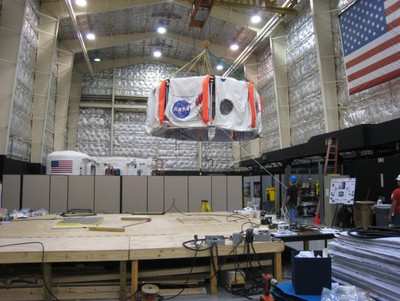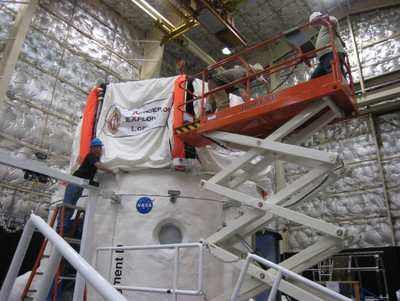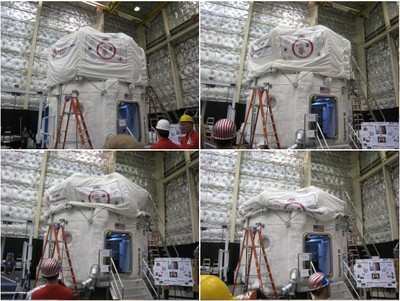Mon, Jul 04, 2011
Inflatable Space "Loft" Concept Take Top Design Honors, $10,000
Prize
University of Wisconsin students topped two other university
teams to win the 2011 NASA eXploration Habitat (X-Hab) Academic
Innovation Challenge, a competition to design and build a space
habitat. The team will now take its inflatable space loft to NASA's
annual Desert Research and Technology Studies (Desert RATS) field
test in Arizona in September. It will be tested as part of a
simulated astronaut mission to an asteroid. "University students
are helping NASA develop potential habitats for future space
missions," said Kriss Kennedy, habitat demonstration unit project
manager at Johnson. "The teams collaborated to demonstrate how
technology we might use in the future could actually be
developed."

NASA Image
The three teams totaling 135 students each spent a week this
month at NASA's Johnson Space Center in Houston setting up and
deploying their inflatable lofts for judging. Teams from Oklahoma
State University, Stillwater, and the University of Maryland,
College Park also competed. "This is a great example of how NASA
can obtain innovative system concepts from universities," said Doug
Craig, strategic analysis manager for analog systems at NASA
Headquarters in Washington. "These technology concepts are a
valuable part of our human space exploration planning
activities."

NASA Image
According to the judges, the 14-member University of Wisconsin
team's design held promise for habitability and application to the
Desert RATS mission simulation and was ready for field use because
it had little leakage in the inflatable systems. The loft will be
part of the home for a crew of four during the field test.
In June 2010, NASA invited university teams to submit inflatable
loft concepts for the X-Hab Challenge. The three competing
universities received $48,000 of seed funding to assist with their
projects.The winning university will receive $10,000 to offset
costs associated with the desert field test.

Deflation Sequence NASA Image
Next year's competition, X-Hab 2012, will look at volume,
geometry and habitability of a deep space habitat and technologies
for plant growth and geo-science sample handling. The competition
is designed to engage and retain students in the science,
technology, engineering and math disciplines, which in turn will
help develop the next generation of innovators and explorers. It
also tests concepts and solutions for potential future NASA
missions.
More News
Also: Outlaw Prop 4 Mooney, Ready 4 Duty, Ukrainian F-16 Pilot Lost, Blue Origin Flt On his journey to become the first pilot to land solo on all seven continents, 19-year-old Etha>[...]
Also: DarkAero Update, Electric Aircraft Symposium, Updated Instructor Guide, OSH Homebuilts Celebrate The long-awaited Sonex High Wing prototype has flown... the Sonex gang tells >[...]
Discrete Code As used in the Air Traffic Control Radar Beacon System (ATCRBS), any one of the 4096 selectable Mode 3/A aircraft transponder codes except those ending in zero zero; >[...]
From 2023 (YouTube Edition): Deviation from the Historical Mean Racine, Wisconsin-based DeltaHawk is a privately-held manufacturer of reciprocating engines for aircraft and hybrid >[...]
Aero Linx: Formation and Safety Team (F.A.S.T.), USA The Formation and Safety Team (FAST) is a worldwide, educational organization dedicated to teaching safe formation flying in Wa>[...]
 Airborne 07.02.25: TikToker Arrested, Vietnam A/L Ground Hit, ATC Modernization
Airborne 07.02.25: TikToker Arrested, Vietnam A/L Ground Hit, ATC Modernization Airborne Affordable Flyers 07.03.25: Sonex HW, BlackShape Gabriel, PRA Fly-In 25
Airborne Affordable Flyers 07.03.25: Sonex HW, BlackShape Gabriel, PRA Fly-In 25 ANN's Daily Aero-Term (07.07.25): Discrete Code
ANN's Daily Aero-Term (07.07.25): Discrete Code Classic Aero-TV: DeltaHawk Aero Engine Defies Convention
Classic Aero-TV: DeltaHawk Aero Engine Defies Convention ANN's Daily Aero-Linx (07.07.25)
ANN's Daily Aero-Linx (07.07.25)





